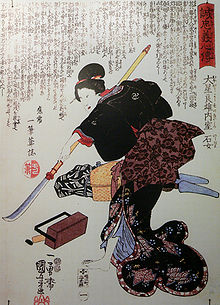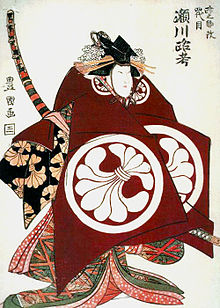- Onna bugeisha
-
An onna-bugeisha (女武芸者) was a type of female warrior belonging to the Japanese upper class. Many wives, widows, daughters, and rebels answered the call of duty by engaging in battle, commonly alongside samurai men. They were members of the bushi (samurai) class in feudal Japan and were trained in the use of weapons to protect their household, family, and honor in times of war. They also represented a divergence from the traditional "housewife" role of the Japanese woman. They are sometimes mistakenly referred to as female samurai, although this is an oversimplification. Onna bugeisha were very important people in ancient Japan. Significant icons such as Empress Jingu, Tomoe Gozen, Nakano Takeko, and Hojo Masako were all onna bugeisha who came to have a significant impact on Japan.
Contents
History
Early history
Long before the emergence of the renowned samurai class, Japanese fighters were highly trained to wield a sword and spear. Women learned to utilize naginata, kaiken, and the art of tantojutsu in battle. Such training ensured protection in communities that lacked male fighters. One such woman, later known as Empress Jingu (c. 169-269 AD), utilized her skills to inspire economic and social change. She was legendarily recognized as the onna bugeisha who led an invasion of Korea in 200 AD after her husband Emperor Chūai, the fourteenth emperor of Japan, was slain in battle. According to the legend, she miraculously led a Japanese conquest of Korea without shedding a drop of blood. Despite controversies surrounding her existence and her accomplishments, she was an example of the onna bugeisha in its entirety. Years after her death, Jingu was able to transcend the socioeconomic structures that were instilled in Japan. In 1881, Empress Jingū became the first woman to be featured on a Japanese banknote. Designed to stop counterfeiting, her image was printed on oblong paper.[1] In addition to economic changes in Japan, onna bugeisha also stretched social structures.
During the earlier Heian and Kamakura periods, women who were prominent on the battlefield were the exception rather than the rule. Japanese ideals of femininity predisposed most women to powerlessness, in conflict with a female warrior role.[2] Women warriors were nonetheless pioneers in this role, and some even went on to lead their own clans.
Kamakura Period
The Genpei War (1180–1185) marked the war between the Taira and Minamoto; two very prominent and powerful Japanese clans of the late-Heian Period. During this time, the epic Heike Monogatari was written and tales of courageous and devoted samurai were recounted. Among those was Tomoe Gozen, wife of Minamoto Yoshinaka of the Minamoto clan. Gozen assisted her husband in defending himself against the forces of his cousin, Minamoto no Yoritomo. During the Battle of Awazu on February 21, 1184, Gozen rode into the enemy forces, flung herself on their strongest warrior, unhorsed, pinned, and decapitated him.[2] In the Tale of Heike, Gozen was described as being "especially beautiful, with white skin, long hair, and charming features. She was also a remarkably strong archer, and as a swords-woman she was a warrior worth a thousand, ready to confront a demon or a god, mounted or on foot. She handled unbroken horses with superb skill; she rode unscathed down perilous descents. Whenever a battle was imminent, Yoshinaka sent her out as his first captain, equipped with strong armor, an oversized sword, and a mighty bow; and she performed more deeds of valor than any of his other warriors."[2]
Although she was not proven to be a historical figure, Gozen has impacted much of the warrior class, including many traditional Naginata schools. Her actions in battle also received much attention in the arts plays such as Tomoe no Monogatari and various ukiyo paintings. As time passed, the influence of onna bugeisha saw its way from paintings to politics.
After the Heike were thwarted towards the western provinces of Japan, the Kamakura shogunate (1185–1333) was soon established under the rule of Minamoto no Yoritomo. After he passed, his wife, Hojo Masako, was the first onna bugeisha to become a prominent player of politics – in the early years of the Hojo regency. Masako became a Buddhist nun, a traditional fate of samurai widows, becoming known as "The General in Nun’s Habit”. She bullied the samurai class into supporting her son, Minamoto no Yoriie, as the first Hojo Shikken (regent) in Kamakura.[3]
Through the collective efforts of Masako and a few political puppets, laws governing the shogun’s court in the early 13th century allowed women equal rights of inheritance with fraternal kin. Even though the primary role of women in ancient Japan continued to be the support to their family and their husbands, they acquired a higher status in the household. These laws also allowed Japanese women to control finances, bequeath property, the upkeep of the home, managed servants, and for raising their children with proper, loyal, samurai upbringing. Most importantly, Japanese women were also expected to defend their homes in times of war.
Edo Period and beyond

Due to the influence of Neo-Confucian philosophy and the established marriage market of the Edo Period (1600–1868), the status of the onna bugeisha diminished significantly. The function of onna bugeisha changed in addition to their husbands. Samurai were no longer concerned with battles and war, they were bureaucrats. Women, specifically daughters of most upper class households, were soon pawns to dreams of success and power. The roaring ideals of fearless devotion and selflessness were gradually replaced by quiet, passive, civil obedience.
Travel during the Edo Period was demanding and unsettling for many female samurai due to heavy restrictions. They always had to be accompanied by a man, since they could not travel by themselves. Additionally, they had to possess specific permits, establishing their business and motives. Samurai women also received much harassment from officials who manned inspection checkpoints.[4]
The onset of the 17th century marked a significant transformation in the social acceptance of women in Japan. Many samurai viewed women purely as child bearers; the concept of a woman being a fit companion for war was no longer conceivable. The relationship between a husband and wife could be correlated to that of a lord and his vassal. "Husbands and wives did not even customarily sleep together. The husband would visit his wife to initiate any sexual activity and afterwards would retire to his own room".[5] Despite the social view of women as being mere means to an end, they were still expected to show solace for death when it came to defending their husband's honor. A wife’s solidarity for the sake of her husband was a common and well receptive theme in Japanese culture. In addition to self-sacrifice, self-renunciation was also an imperative quality a Japanese woman had to possess until the dawn of the 20th century.
In 1868, during the Battle of Aizu, a part of the Boshin War, Nakano Takeko a member of the Aizu clan, was recruited to become leader of a female corps who fought against the onslaught of 20,000 Imperial Japanese Army of the Ogaki domain. Highly skilled at the naginata, Takeko and her corps of about 20 joined 3,000 other Aizu samurai in battle. The Hokai Temple in Aizu Bangemachi, Fukishima province contains a monument erected in her honor.
Weapons
The naginata is a long rod with a curved blade at the tip. Due to its versatility and convention, more women have been attracted to its use. It offers a wide variety of long ranged techniques due to its length. It also proved to be very efficient against marauders who often attacked on horseback. A bow and arrow would also be used due to its even wider attack range. Additionally, the naginata was proven to be effective in close quarter combat. Considering the usual strength advantage men had over women, a strong woman armed with a naginata could keep most combatants at bay. It was during those circumstances where strength, weight, or sword counted for less. Through its use by many legendary samurai women, the naginata has been propelled as the iconic image of a woman warrior. During the Edo Period, many schools focusing on the use of the naginata were created and perpetuated its association with women.[6]
See also
- Kunoichi
- Nakano Takeko
- Hangaku Gozen
- Tomoe Gozen
- Woman warrior
References
Sources
- Szczepanski, K. (2009). Samurai Women of Japan. Library of Congress Prints Collection. About.com: Asian History. 3 December 2009.
- Beasley, W.G. (1999). The Japanese Experience: A Short History of Japan. University of California Press.
- Amdur, Ellis. (2009). Women Warriors of Japan: The Role of Arms-Bearing Women in Japanese History'.' Koryu Books, 2009.
External links
Categories:- Japanese women in warfare
Wikimedia Foundation. 2010.


